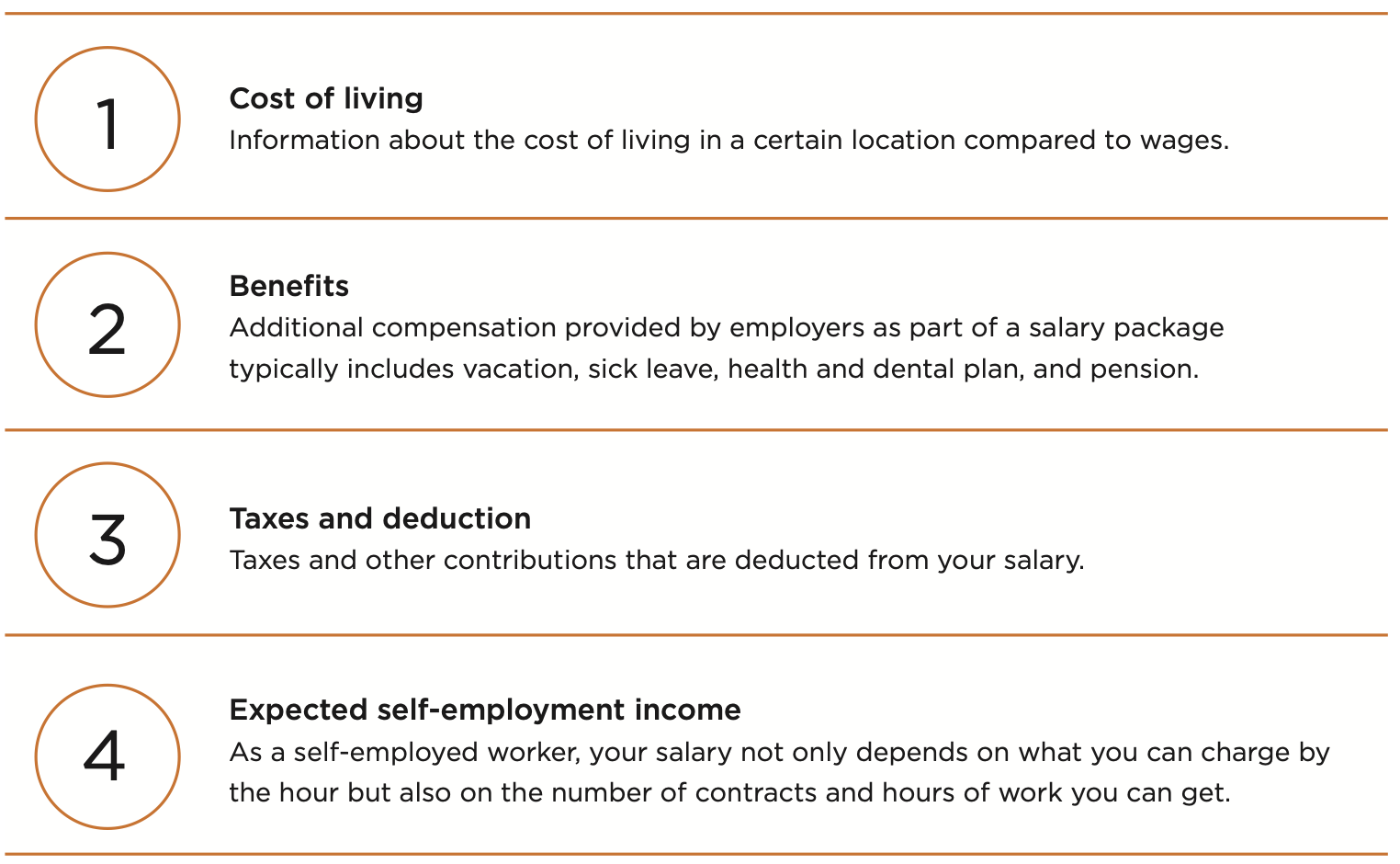Table of Contents
Key Findings
- Young Canadians at the crossroads of high school and post-secondary education want wage information to validate their education and career decisions. We held a series of in-depth discussions with 35 young Canadians to better understand the types of information they’re seeking.
- Students want wage information to be highly customizable (e.g., annual, hourly, etc.) to fit their specific needs and circumstances. They also want to compare wage data across as many dimensions as possible (e.g., information by occupation, field of study and location).
- Insights into wages by field of study two years after graduation as well as current wages by occupation will support students in their choices.
- Students seek information that complements wage information such as taxes, deductions, benefits, cost of living, etc. to help them better understand the affordability of a chosen career path.
Introduction
The Labour Market Information Council (LMIC) partnered with Refresh Market Research to conduct an online qualitative study of first-year college and university students. In-depth discussions with 35 young Canadians helped us learn more about why they decided to pursue post-secondary education (PSE) and specifically about how they chose their field of study and institution. We then dug deeper to find out what types of labour market information (LMI) had been or could be useful in making these decisions. The group discussed three types of LMI: wages, skills and job outlooks (i.e., forecasts of the number job openings). This LMI Insight Report focuses on wages and what wage information is most useful to them.
This study builds on the findings of the public opinion research that LMIC previously conducted by surveying nine groups of Canadians. One of the surveys, focusing on college and university students, revealed that wages were the single most sought-after LMI among this group. The study aimed to narrow down the wage information needs of students and how LMI providers can improve its structure to better inform the decisions of those stepping into PSE (see Box 1).
Customizable wage information for decision making
We learned that the decision to pursue higher education is primarily shaped by personal interests (see LMI Insight Report no. 11). However, once they start thinking about career paths related to their educational choices, the students surveyed actively seek detailed information on potential earnings to ensure it aligns with their desired lifestyle and, ultimately, validates their choice.
“[Hourly wages are] easier to compare with what [I] know.”
We tested different formats for providing information on wages and found that the most relevant one depends on the individual student’s experience with the labour market and the exact decision at hand. Annually or
hourly wages were perceived to be equally relevant formats (compared to weekly, biweekly or monthly wages). In some cases, hourly wages were preferred because it is the format which students are most familiar. Annual salaries were preferred when thinking about longer-term careers.
Students link fields of study to occupations when thinking about wages
Students were asked to evaluate the importance of wages expressed in different formats, such as by occupation, industry, training/education or location.
Participants considered information on wages by occupation as the most important because “it is the most specific” and can help them pick a field of study. As one student put it, “knowing what occupations provide good wages could play a key role in what career path you decide to take.”
Wage information by education/training was identified as the second most important way to provide wage information. The participants said, “[the annual salary] suggests the job is a long-term, full-time job with 35-40 hours of work a week.” This kind of information helps them understand how much education or training a person would need to get their desired salary or career.
Box 1: Online qualitative study methodology
We partnered with Refresh Market Research to engage students in an in-depth online discussion focusing on their use of LMI to make choices about their PSE and career pathways.
In total, we recruited 35 participants aged 17–20 who had just completed their first year of PSE, or completed their last year of high school in the spring of 2019 and were enrolled in a PSE program starting in the fall. As shown in the table below, participants represented a broad range of regions and types of institutions.
| Distribution | Categories | Number of Participants |
|---|---|---|
| Geographic Distribution | North (Yukon, Northwest Territories and Nunavut) | 5 |
| West (British Columbia, Alberta, Saskatchewan and Manitoba) | 9 | |
| Ontario | 6 | |
| Quebec | 7 | |
| East (Nova Scotia, New Brunswick, Prince Edward Island, and Newfoundland and Labrador) | 8 | |
| Type of PSE Institution | Technical/Vocational College | 2 |
| Community College | 5 | |
| University | 28 |
This project, rolled out between April and May 2019, consisted of a series of engaging and thought-provoking exercises during a three-day online discussion. Prior to the discussion, participants were given homework to make them think about their educational journey from when they initially considered a career to selecting their field of study and enrolling in a post-secondary institution.
Location is less important than occupation or field of study
While information on potential earnings for a specific occupation is very important, students also wanted the option to compare wage data across as many dimensions as possible (e.g., information by occupation, field of study and location). Those who collect and communicate LMI know that generating local, granular information is a challenge and trade-offs often need to be made.
To get the students to consider some of these trade-offs, we presented them with a series of statements about wage information. They were then asked to select the one that made most sense to them and explain why. One such statement compared a specific field of study in a broad region (e.g. Mechanical Engineering in Ontario), with a broad field of study in a specific city (e.g. Natural Sciences in Toronto). Participants tended to favour wage information for a specific occupation at the provincial level as “it specifies one certain career rather than a whole field,” and because it is more understandable, relatable and relevant.
How much will I make two years after graduation?
The time period in which wage information is reported also matters to students. We presented them with statements on wages for the current year as well as in two, five and ten years, and asked them to rate the different pieces of wage information by importance.
Students thought current wage information was an excellent indicator of future wages. They considered current information to be more accurate and trustworthy than a projection into the future. Even historical wage information that is a few years old can help them understand how that career is faring.
Despite recognizing the greater reliability of current wage information, most participants wanted to know what graduates from their field of study would likely earn two years after completing their program. This is a timeframe that matches when they plan to “be in the workforce” in their desired career. The students thought this information would help them prepare for the future. As one participant said, it would “give some insight into what you will be doing when you start.”
Tell me more: Benefits and cost of living
Although essential, wage information without further context can be insufficient for making informed educational and career decisions. We therefore asked students to tell us what other information would help them make up their minds. We presented them with additional data related to wages that they might need to make a good decision. We then asked them to assess if they were important or not. Participants placed information that complements standard earnings in order of importance: 1) cost of living, 2) benefits, 3) taxes and deductions and 4) expected self-employment income.
Figure 1: Most sought after additional labour market information

Cost of living information was deemed to be the most important by participants because, together with wages, it can help determine if the offered wage of a given job is sufficient to cover living expenses. Cost of living data further helps job seekers decide where to live and work, and is beneficial for budgeting purposes.
Information on benefits took second place. Participants also considered this information to be very useful as it helps them to better compare job offers and identify how much additional money they’ll need for savings and insurance. We also asked the students to consider net income (after taxes and deductions) and gross income (before taxes). Most prefer salaries expressed as net take-home pay.
The Way Forward
Choosing a post-secondary education program is an important and sometimes stressful decision. Students want all possible information before stepping onto their future educational and career paths. Our research on the
LMI needs of students points to wage information as undoubtedly one of the key pieces of data being sought.
Our in-depth conversations with young Canadians show that information on wages is used to confirm their decisions about career path. It helps them validate their choice and understand if it corresponds to their desired lifestyle. Three clear recommendations to providers of LMI emerge from this research.
First, information needs to be customizable to individual needs. Hourly wages might make more sense to one student but another might make better use of annual salaries.
Second, the most useful wage information is forward-looking and related to the student’s expected career path. The students have a strong preference for average wages of graduates from their field of study two years after completing the program, as well as average wages in their desired occupations.
Third, information needs to be contextualized to provide a clear picture of their expected lifestyle. Information on net wages after taxes and deductions, and additional information on the cost of living, should accompany wage information.
LMIC will be working with its federal, provincial and territorial colleagues, as well as its nongovernmental partners, to fine-tune its recommendations, support LMI producers and, ultimately, promote best practices in communicating information to Canadian students to support their education and career choices.
Acknowledgments
This LMI Insight Report was prepared by Kevin Saade and Emna Braham of LMIC. For more information about this LMI Insight Report or other LMIC activities, please check our publications page. You may also contact Emna Braham at emna.braham@lmic-cimt.ca or Tony Bonen (Director, Research, Data and Analytics) at tony.bonen@lmic-cimt.ca.
Check out the Survey Results by Population Groups dashboard and previous editions of LMI Insight Reports discussing the needs, challenges and difficulties of finding labour market information. Additional results will be made available as analyses are completed.


